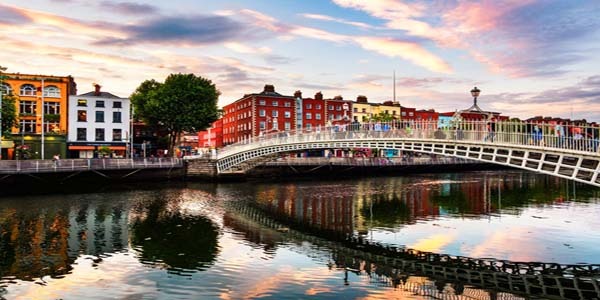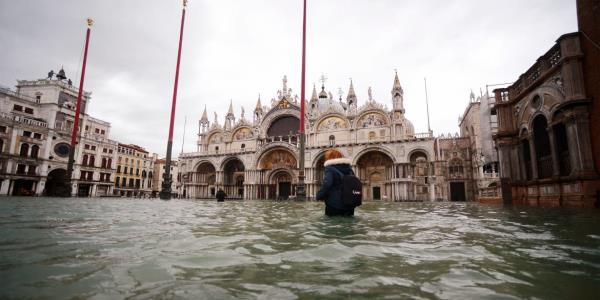What are the best things to do in Dublin was definitely the first question you asked yourself when you decided to fly to the Irish capital. There is certainly no shortage of things to do in Dublin, spending your stay visiting monuments and attractions in or around Dublin will engage you completely the time you spend in the city.
Multiculturalism, however, has not affected the leathery, irreverent and bloodthirsty character of the Irish who, if before they had to leave the city to live better, today they need to work hard not to lose what they have conquered in the last 20 years. The cost of living, especially real estate, is very high and this obliges citizens to exhausting tour de force to maintain the onerous rent of the house or pay the mortgage installment. Then, however, there is the fun that passes through the sport (rugby and football on all) and the evenings in the pub. Beer and whiskey (without exaggeration!) are a great tool to find that “positive side” that we mentioned at the beginning. Here are our tips for what to do on a vacation in Dublin. Enjoy reading.
Things to do in Dublin: Trinity College
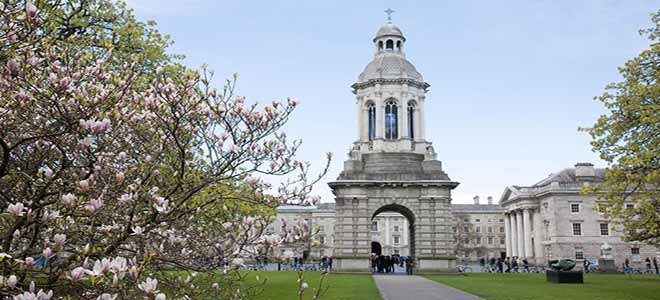
Trinity College is the oldest and most prestigious university in Ireland. It is located in the center of Dublin and for many years has been a key hub for the training of students from all over the world. A cosmopolitan vocation that, however, has had to struggle to establish itself. The university, in fact, was founded in 1592 by Elizabeth I of England in order to stem the “flight” to the continent of many young Irish Protestants in search of a better education. A haemorrhage of talents that worried the queen especially for the risk of “papist” influences in the education of the boys.
This also explains the centuries-old prohibition for Catholics to attend university, to the point that when the rules became less rigid it was the Church itself that prohibited (under penalty of excommunication) the attendance of Catholic students at the university. The barriers fell definitively in 1970 but the university, which already boasted considerable prestige, did not delay in making up for lost time, transforming itself into the pole of excellence described in the opening. An internationally renowned university that, in addition to its degree courses (see official website: www.tcd.ie) is also famous from a museum point of view.
Read also: Best cities to visit in Ireland
The reference is to the “Old Library”, the ancient library of the university where is kept the precious Book of Kells (Book of Kells) manuscript of the ninth century with the 4 Gospels of the New Testament. To realize the tome were the amanuensis of the Scottish monastery of St. Columbus sheltered in Ireland to escape the Viking raids. In short, in Trinity College, pleasant shelter from the hustle and bustle of the city, lives the “genius loci” of Dublin, which is why we put it in first place among the things to do in Dublin.
Botanical gardens Glasnevin
The Glasnevin Botanical Gardens are less than 4 km from Dublin city center and can be easily reached by bus (buses 4, 9 and 83). They are huge Art Nouveau greenhouses built in the late 1800s to house exotic plants and one of the most important collections of orchids in Europe. Also visit the monumental cemetery of Glasnevin.
Read also: Best beaches in Spain
What to do in Dublin: Dublin Castle
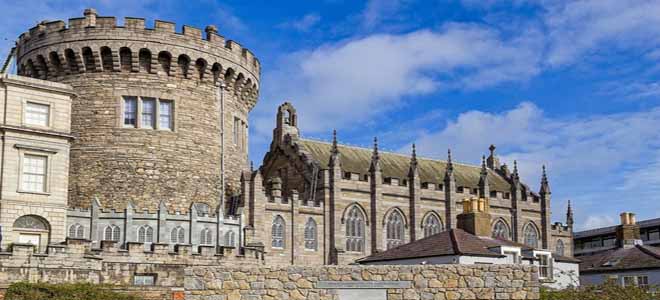
“We have been waiting for 700 years, you can wait 7 minutes”. These are the famous words with which Michael Collins, in 1922, replied to the English viceroy who had reprimanded him for the delay during the ceremony of the handing over of the castle to the Free State of Ireland. For 700 years, in fact, Dublin Castle has represented the stronghold of British power, and for this reason it was assaulted several times by the Irish Independents over the centuries. To say, in St.Patrick’s Hall, the room used for the settlement of the Presidents of the Republic (which can be visited together with the State Appartments during the guided tours) James Connoly, another hero of the Irish resistance, the creator of the famous Easter riots of 1916, was held prisoner.
Read also: Best places to visit in Liverpool
Wounded during the clashes, Connoly was treated and later shot by the British. In short, Dublin Castle, together with the Trinity College previously mentioned, is another must for those who want to learn more about the things to do in the Irish capital. A history written with blood, whose importance goes far beyond the tourist aspects of the visit. In fact of the original medieval Anglo-Norman fortress remains only the Record Tower, the circular tower clearly visible from the outside. In 1986, during a campaign of excavations, the foundations of the original fortress built in the thirteenth century emerged. The foundations that today, together with the State Apartments previously mentioned, constitute the most important point of the visit. For more information on history, entrance times and guided tours, please visit www.dublincastle.ie.
Cathedral of San Patrizio
According to legend, the Cathedral was built on the exact spot where St. Patrick baptized the Irish pagans who decided to convert. And in fact under this church, the largest in Ireland, flows the underground river Paddle which is why, despite several renovations of the building over the centuries, it was never possible to build a crypt. Even today, inside the church, a cross placed on a stone slab would indicate the position of the well from which the saint would have drawn for his conversion activity. This is not the only legend. Another one, dated 1492, tells of a dispute between the supporters of the Count of Kildare and the Count of Ormond. A nephew of the latter – according to the story – barricaded himself in the chapter house of the church and this necessitated a compromise between the parties to end the hostilities.
Discover the best places to visit in Berlin
Compromise that saw the protagonist Count Kildare who, to prove his good faith, drilled a hole in the door of the room and put an arm in it with the real risk that he would be amputated. And instead, fortunately, his hand was shaken, which helped to settle the dispute. From this episode, the Irish proverb “to chance your arm” which means precisely to be willing to take some risk to achieve their goals. Not only legends. In St. Patrick’s Cathedral, where the contrast between the austere façade and the liveliness of the interior stands out, more than 500 illustrious personalities from Dublin and Ireland are buried. Among them, Jonathan Swift, author of the famous novel “Gulliver’s Travels”, and long dean of the church. Church that, we remember, is not a bishop’s seat, merit, the latter, which is instead the responsibility of the other city cathedral, the “Christ Church” (see next paragraph). For more information about what to do in Dublin and St. Patrick’s Cathedral visit the official website: www.stpatrickscathedral.ie.
Cathedral of Christ Church
Unlike St. Patrick’s Cathedral, Christ Church (or “Church of the Holy Trinity”) has a crypt. In fact, visiting the medieval crypt is among the most attractive things to do in Dublin’s cathedral, the one where most of its most precious goods and artifacts are kept. From the logs formerly used by religious authorities to the detriment of civilians, to rare coins and royal coats of arms. Woe betide to forget “Tom & Jerry”, a mummified cat and mouse found inside an organ pipe in 1860 and later renamed by the Dubliners as the historic cartoon.
Do you know what is the most beautiful city in Switzerland?
The crypt, whose construction dates back to the twelfth century, is the only part of the church to have preserved the original architectural imprint. For the rest this church, cathedral of the Anglican diocese and seat of the patron saint of Dublin Lawrence O’ Toole, has undergone numerous renovations with the inevitable overlapping of different styles. To the original Romanesque-Gothic style was added the Victorian style following the last renovation between 1871 and 1878 after centuries of neglect and oblivion. For more information on the history, visits, events and pastoral activities visit the site: christchurchcathedral.ie.
What to do in Dublin: Temple Bar
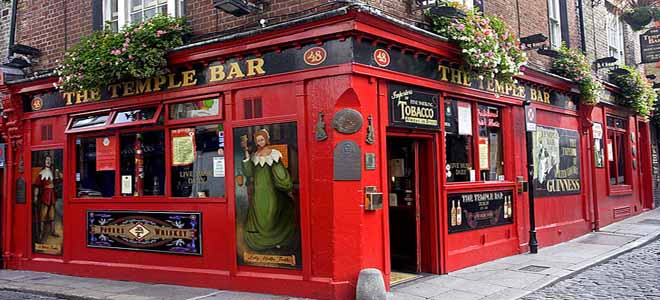
After chasing Dublin’s “genius loci” among universities, castles and churches, one of the best things to do in Dublin is to stop for a drink in one of the many pubs in Temple Bar, the city’s tourist center. A maze of streets where pubs, restaurants, boutiques and quality stores follow one another. The area, in the nineteenth century frequented by drunks and malefactors, in the 50s of the last century experienced a first phase of rebirth, culminating in the opening of numerous craft stores. Then a new phase of oblivion, interrupted only at the beginning of the 90s when Dublin was designated European Capital of Culture (1991).
From there the appearance of numerous commercial activities, however, included in a wider project of territorial redevelopment. A work certainly successful from an urban planning point of view, even if at the expense of the popular imprint that had characterized the area for centuries. Today Temple Bar is frequented mainly by young people who, especially on weekends, pour into pubs to party. Often more than allowed, with some problems of public order. Net of these criticalities, which certainly clash with the needs of a less festive and more cultured type of curious traveler, Temple Bar deserves also from the cultural point of view: the “Gallery of Photography”, the Old Not to be missed!
Read also: Things to do in Denmark
Things to do in Dublin: Grafton Street
Wandering what do to in Dublin? The shopping street par excellence, full of boutiques and excellent stores to meet the needs of the most diverse social groups. From those interested in buying jewelry and designer clothes, to artists and intellectuals who find everything they are looking for in the environment of this pedestrian island south of the Liffey River: books of course, but also music to buy, or to listen to in the street among singer-songwriters and performers of all kinds.
National Gallery
The history of Ireland’s most important museum is a history of works of art (the Gallery houses paintings from the major European schools of painting from the 14th to the 20th century) and some great men. Great even when they are “wrong” as Martin “The General” Cahill, the gangster who for thirty years raged in a Dublin already torn by the conflict between Catholics and Protestants. Together with his gang, in 1992 Cahill was the protagonist of a spectacular theft inside the National Gallery of Ireland.
Discover the 50 best places to visit in England
Several paintings from the “Beit collection” (one of the 4 in which the museum is divided) were stolen, including the famous “Lady writing a letter with her maid” by the Flemish painter Jan Vermeer. A case of striking news that inevitably aroused the curiosity of the film industry that to the episode, and more generally to the life of the bandit, in 2000 dedicated a film (“The General”) with Kevin Spacey in the lead role. But, we were saying, there is not only Cahill in the history of the museum. Woe betide to forget the Irish writer and playwright George Bernard Shaw who even bequeathed a third of his royalties to the gallery. Or, going backwards, William Dargan, Irish railway magnate and founder of the museum. In addition to the painting by Vermeer on recalled, do not miss the “Capture of Christ” by Caravaggio. For more information about the museum: www.nationalgallery.ie
St. Stephen’s Green
St. Stephen’s Green is the park in central Dublin. Reachable in 10 minutes walk from Temple Bar is a corner of paradise with lakes and waterfalls, surrounded by beautiful Georgian houses. It is the ideal place to relax and read a good book. Remember, however, that in Ireland it is forbidden to drink outdoors, so no beer in the green even if this is one of the best things to do in Dublin!
Discover what to do in Sintra
Guinness Storehouse
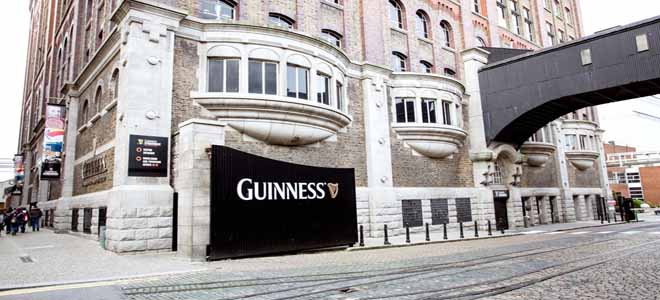
For the Guinness Storehouse what already written about Temple Bar is valid. Also the Guinness Museum is a very successful experiment from the architectural point of view but, at least according to many Dubliners “doc”, would have lost the community trait that for centuries has linked the old factory of Arthur Guinness to the city. It will be. The fact remains that the Guinness Storehouse is by far the most visited place in Dublin and the whole of Ireland. From 2000 to today this building of 7 floors whose structure recalls, not even to do it on purpose, that of a pint of beer, has been visited by millions of tourists from all over the world.
Read also: What to see in Amsterdam
During the guided tour, the ingredients (water, barley, hops and yeast), the process (from boiling to mixing), transport, the ancient craft of coopers and, of course, the biography of the founder are explained. At the end, unfailing, comes the tasting at the “Gravity Bar”, on the top floor of the museum. A huge room, surrounded by stained glass windows, where you can stop and taste Guiness in the company of a beautiful view of the city. In short, it will also be a skillful marketing strategy, but it is also worth a visit. For more information on prices and opening hours please visit the official website: www.guinness-storehouse.com
What to do in Dublin: Dublin Zoo
Zoos generally divide public opinion, and therefore the fact that almost all of the zoos in Dublin have positive reviews speaks in favor of the structure. The spaces available to the animals, in fact, are large and well cared for, which shows the attempt to recreate, as far as possible, the best habitat for each species present. Rhinos, elephants, lions, giraffes, macaques, tigers, polar bears, but also chickens, goats, cows and pigs: in this zoo, one of the oldest in Europe, there is really everything. Ideal destination and best thing to do in Dublin especially for those who move with children in tow. By the way, the zoo is located inside the Phoenix Park, one of the largest city green lungs in the world, more than double the size of New York’s famous Central Park. For more information on prices, opening hours, routes and anything else visit the official website: www.dublinzoo.ie
Kilmainham Gaol Prison in Dublin
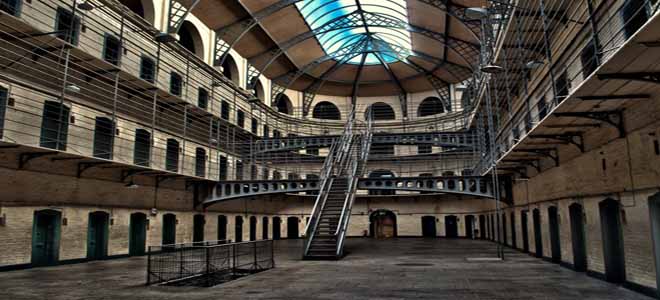
You cannot visit Ireland and Dublin without passing through here. Entering Kilmainham Gaol prison means taking a closer look at the history of this country. It is in fact here, among these cold, gray and bare cells, that the most important political battle for the independence of Ireland was fought. Many common criminals and political rebels have crossed the threshold of this prison, never to leave it alive again. These were in fact executed in the inner courtyard of the prison, a place used for executions.
Today the prison is no longer active and has become a museum. It was also chosen as the location by U2 to record one of their music videos; the cinema also entered here, using Kilmainham Gaol as the set for numerous films, including “The Father’s Name”, a glimpse into the resistance and abuse suffered by the Irish during the British occupation. Located in the west of the city, a visit to Kilmainham Gaol prison is the most emotionally challenging stop on the entire day trip with interesting things to do in Dublin. During the visit it is possible to be locked inside one of the many cells of the prison, to understand first hand the feeling of anguish that each prisoner lived behind bars; you will also be able to observe at close quarters numerous clothes, letters and other personal objects of some of its most famous “guests”.
Here are all the things to do in Slovenia
The Spire in Dublin
The Spire, the “pin”, is a giant 120m high steel tower located in the center of O’ Connell Street, one of the most important avenues in Dublin and easily accessible from the bridge of the same name. We are located in the northern part of the city, the one that was once mistreated and mistreated by Dubliners south of the Liffey River, because it was said to be frequented by ragamuffins and criminals. Today it is no longer so, because O’ Connell Street is a nerve center, artery of a very elegant area, full of pubs, fast food, high fashion stores and services of all kinds.
The story of The Spire has no official version; there are those who say, maliciously, that it is the pin that mockingly stung the unnobleed areas of the King of England, and for this reason a symbol of the rebellion against the long English domination; others say it is a monument symbolizing the fight against the use of heroin, very widespread in Dublin in the 90s; those who say it is simply a monument to the light or that the tower serves only as a beautification of the skyline of the city. The only certain news is that until 1966, in place of The Spire there was the statue of the English Admiral Horatio Nelson, blown up with a bomb by the IRA, the Irish military independence organization.
Read also: What to see in Barcelona
Ha’ Penny Bridge: Dublin’s iconic bridge
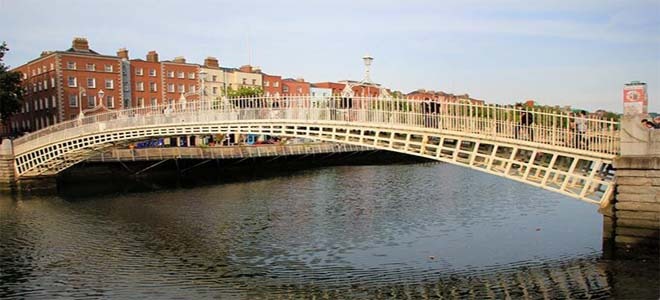
If there is a place of interest widely photographed in the city, that is the Ha’ Penny Bridge, the third stop in this guide to visit Dublin. From Trinity College it will be only a few hundred meters away. In this way you will also pass by what turns out to be the most famous district of Dublin: Temple Bar. Built in 1816 the Ha’ Penny Bridge connects the two banks of the Liffey River. You will ask yourselves why the name “Penny”…when it was built, who wanted to cross the bridge had to pour “half a penny”, simpler than that… (imposed until 1919).
Things to do in Dublin: Phoenix Park
The largest park in Dublin is Phoenix Park. It is a real nature reserve where deer live freely. Meeting them is easy and the view is quite surreal, especially in the early morning and in the evening when you see them standing out against the horizon with the typical Dublin fog around. It is located a bit outside the center and can be easily reached by bus.
Grand Canal
The Grand Canal area is another little known and touristic part of Dublin, but very beautiful. On the banks of the canal you can lie down to sunbathe and eat a little in the various pubs and clubs nearby. The canal is bordered by a pedestrian street surrounded by green meadows, colorful barges and Georgian-style houses. If you go westwards you will feel as if you are in a village that has stopped in time, if you go eastwards you will get closer and closer to the Docklands area (recently redeveloped and to be visited) where skyscrapers and other contemporary structures stand out.
Molly Malone
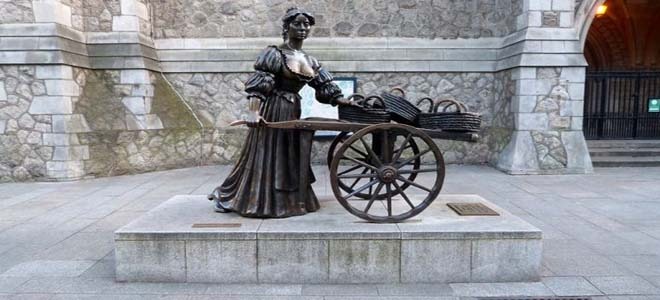
Visiting Dublin without saying goodbye to Molly Malone and without taking a photo with her is considered by many a sacrilege. The statue of the fishwife Molly Malone, whose ghost, according to legend, hovers in the alleys of Dublin during foggy nights, is the symbol of the city and the character sung in the famous folk song that is the unofficial anthem of the city of Dublin. The statue of Molly Malone is located in Grafton Street, a stone’s throw from Trinity College.
Here are all the things to do in Oslo
Chester Beatty Library
The Chester Beatty Library is a very special library. Opened in 1950 to house the collection of the magnate Sir Alfred Chester Beatty, it is one of the largest holdings of Islamic and Far Eastern art. The library contains priceless miniatures, prints, drawings, books and artifacts (including the only existing copy of the Gospel of Mani, the sacred text of Manichaeism). Last but not least, we have not tried the cafeteria, but they say it is excellent.
Stroll along the Liffey to Jeanie Johnston
The Liffey is the river that flows through Dublin and, for me, one of the dearest places in the whole city. Spectacular sunrises, breathtaking sunsets, games of reflexes: the Liffey is generous with those who are hungry for beautiful things to do in Dublin. Stroll along its banks on the pedestrian walkways and discover its bridges, one different from the other. Among the most beautiful are certainly the Ha’penny Bridge and the futuristic Samuel Beckett Bridge. Proceeding towards the port of Dublin, along the north shore, at some point you will come across a large sailing ship. It is the Jeanie Johnston, a reproduction of one of the boats on which Irish immigrants sought their fortune overseas during the Great Famine.

